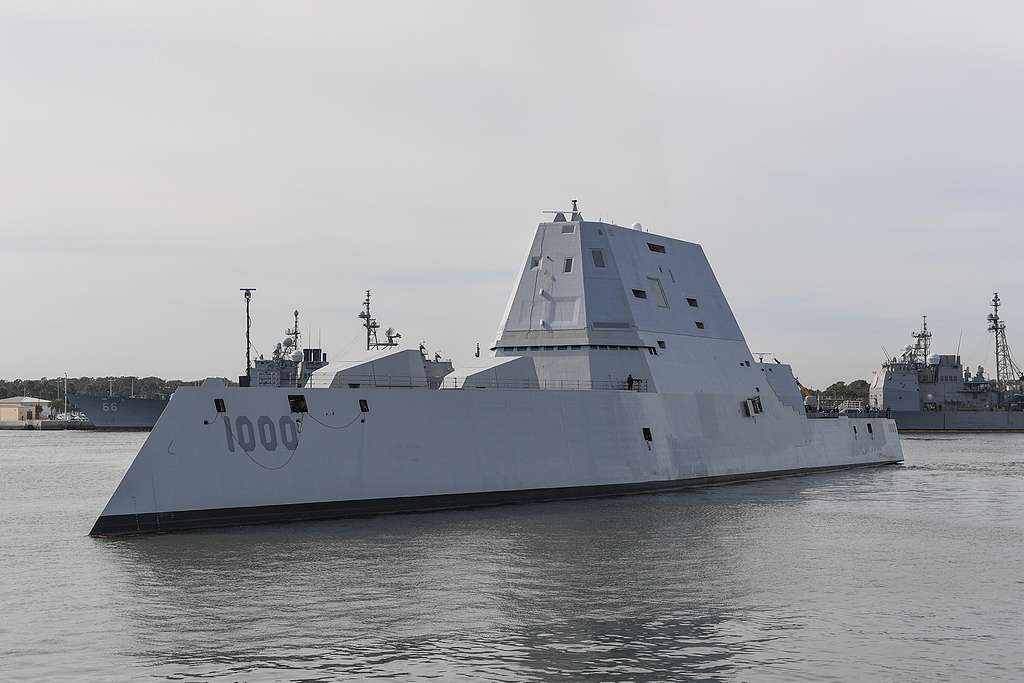
The US Navy plans to equip the Conventional Prompt Strike (CPS) Hypersonic missile aboard its three Zumwalt-class destroyers.
The CPS Hypersonic missile will replace the inactivated 155mm Advanced Gun Turrets aboard USS Lyndon B. Johnson (DDG 1002), USS Zumwalt (DDG 1000), and USS Michael Monsoor (DDG 1001).
The US Navy has also clarified that Zumwalt-class destroyers have two stealthy triangular 155mm Advanced Gun Turrets (AGS) in the forward hull. When not operational, the AGS’s gun barrel is cradled inside the angled housing with the turret’s doors remaining closed to optimize the ship’s stealth profile. During operations, the turret doors open and the gun barrel elevates outward as the turret rotates.
Originally, the AGSs was designed to provide Long-Range Precision Fires (LRPF) shore bombardment of approximately 37 to 62 miles (60 to100 kilometers) in support of amphibious operations. However, the AGSs never lived up to their intended roles since the extended-range GPS-guided shells cost a whopping $800,000 to $1 million each.
As a result, the 155mm AGSs were deemed “Inactive Status” by the U.S. Navy’s Naval Sea Systems Command (NAVSEA) as the Navy and NAVSEA weighed options on its use. Ideas ranged from exploring the production of more cost effective 155mm shells, fielding Hypervelocity Projectile (HVP) to their complete removal and replacement by more Vertical Launch System (VLS) cells. For years, ideas, rumors, speculations and suggestions did the round on how best to replace the AGSs.
Earlier this year, the US Navy decided to replace the 155mm AGS turrets with Hypersonic missile VLS tubes for the Conventional Prompt Strike (CPS) Hypersonic missile.
Incidentally, the CPS Hypersonic missile is a joint collaboration between the US Army and the US Navy.
The first usage of the CPS Hypersonic missile for the US Navy will be around 2025 aboard the Ohio-class guided-missile submarines (SSGNs).
The US Army is however slated to receive the Hypersonic missiles, which it terms as the “Long-Range Hypersonic Weapon (LRHW)” sometime around 2023.
The CPS uses a Common Hypersonic Glide Body (C-HGB) that separates from the missile and flies downwards towards the target at speeds greater than Mach 5 destroying the intended target with kinetic force.
The CPS missile is likely to have a range of of more than 1,724 miles (2,775 kilometers).
“The CPS Hypersonic missile to too large to fit inside the standard MK 41 VLS cell aboard U.S. Navy AEGIS warships and the MK 57 Vertical Launch System aboard the three Zumwalt-class destroyers,” said a source.
When asked to respond to requests for comments on the US Navy’s plans to integrate the CPS Hypersonic missile into the three Zumwalt-class destroyers, Lt. Lewis Aldridge, CHINFO, stated, the retrofitting of the “DDG 1000 Dry-Docking Selected Restricted Availability (DSRA) will begin in FY 2024.”
He went on to add, “Conventional Prompt Strike (CPS) Hypersonic Missiles will only occupy the AGS turret spaces when implemented aboard Zumwalt-class destroyers.”
“The Navy began engineering planning efforts to accommodate integration of CPS on Zumwalt-class destroyers, which includes removal of advanced gun system mounts and installation of Advanced Payload Module (APM) launcher technology.”
“There are currently no plans for additional hull space on the Zumwalt-class destroyers to be filled with MK 41 or MK 57 VLS cells.”




